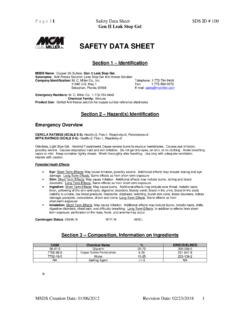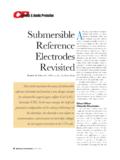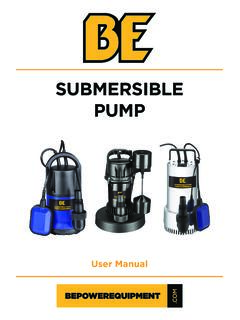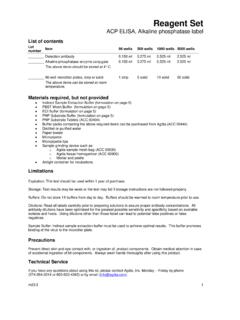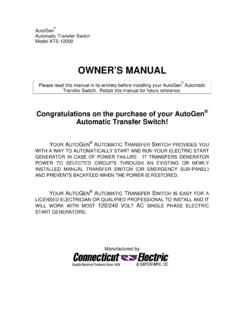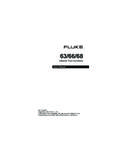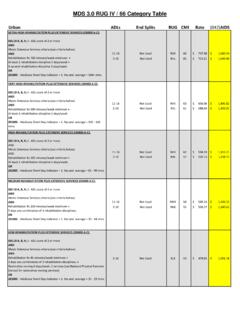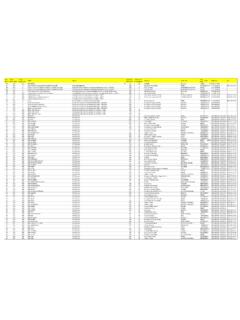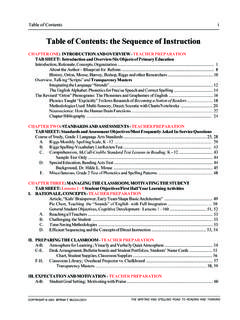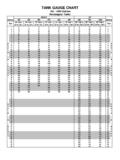Transcription of SDS #25Copper (II) Sulfate Pentahydrate 10.25.2016
1 P a g e | 1 Safety Data Sheet SDS ID # 25 Copper (II) Sulfate Pentahydrate MSDS Creation Date: 11/14/2001 Revision Date: 02/23/2018 (1) Section 1 Identification MSDS Name: Copper (II) Sulfate Pentahydrate Catalog Numbers: 4107, 4110, 14550, 14555, 14630, 14640, 14645, 14665, 14807, 14909, 15100, 15102, 15104, 15105, 15108, 15109, 15210, 15301, 15620, 15625, 16825, 16906, 17003, 17105, 17207, 17225, 17240, 17250, 17270, 17280, TRI014, TRI015. SIN015, SIN0155. Synonyms: Blue Vitriol. Company Identification: Miller CO. 11640 Hwy 1 Sebastian, Florida 32958 For information, call: 1-772-794-9448 Fax Number: 1-772-589-9072 2 Hazard(s) Identification Signal Word: Danger Pictograms: Emergency Overview Appearance: blue crystals.
2 Warning! Harmful if swallowed. Causes eye and skin irritation and possible burns. Causes digestive and respiratory tract irritation with possible burns. Hygroscopic (absorbs moisture from the air). Severe marine pollutant. Target Organs: Blood, kidneys, liver. Potential Health Effects Eye: Exposure to particulates or solution may cause conjunctivitis, ulceration, and corneal abnormalities. Causes eye irritation and possible burns. Skin: Causes skin irritation and possible burns. Ingestion: Harmful if swallowed. May cause severe gastrointestinal tract irritation with nausea, vomiting and possible burns. Ingestion of large amounts of copper salts may cause bloody stools and vomit, low blood pressure, jaundice and coma. Ingestion of copper compounds may produce systemic toxic effects to the kidney and liver and central nervous excitation followed by P a g e | 2 Safety Data Sheet SDS ID # 25 Copper (II) Sulfate Pentahydrate MSDS Creation Date: 11/14/2001 Revision Date: 02/23/2018 (2)depression.
3 Inhalation: May cause ulceration and perforation of the nasal septum if inhaled in excessive quantities. Causes respiratory tract irritation with possible burns. Chronic: May cause liver and kidney damage. May cause anemia and other blood cell abnormalities. Individuals with Wilson's disease are unable to metabolize copper. Thus, copper accumulates in various tissues and may result in liver, kidney, and brain damage. Adverse reproductive effects have been reported in animals. Laboratory experiments have resulted in mutagenic effects. Chronic copper poisoning in man is recognized in the form of Wilson's disease. Section 3 Composition/Information on Ingredients CAS# Chemical Name % EINECS/ELINCS 7758-99-8 Copper (II) Sulfate Pentahydrate 231-847-6 Hazard Symbols: XN Risk Phrases: 22 36/38 Section 4 First-Aid Measures Eyes: Immediately flush eyes with plenty of room temperature water for at least 15 minutes, occasionally lifting the upper and lower eyelids.
4 If symptoms persists, after 15 minutes of irrigation, get medical aid. Skin: Get medical aid. Flush skin with plenty of water for at least 15 minutes while removing contaminated clothing and shoes. Wash clothing before reuse. Ingestion: Do not induce vomiting. If victim is conscious and alert, give 2-4 cupfuls of milk or water. Never give anything by mouth to an unconscious person. Get medical aid immediately. Notes to Physician: Individuals with Wilson's disease are more susceptible to chronic copper poisoning. Antidote: The use of d-Penicillamine as a chelating agent should be determined by qualified medical personnel. Section 5 Fire-Fighting Measures General Information: As in any fire, wear a self-contained breathing apparatus in pressure-demand, MSHA/NIOSH (approved or equivalent), and full protective gear. During a fire, irritating and highly toxic gases may be generated by thermal decomposition or combustion.
5 Substance is noncombustible. Extinguishing Media: Use extinguishing media most appropriate for the surrounding fire. Flash Point: Not applicable. Autoignition Temperature: Not applicable. Explosion Limits, Lower: Not available. Upper Flammable Limit (UFL): Not available. NFPA Rating: (estimated) Health: 2; Flammability: 0; Instability: 0: Reactivity: 1 Hazard Scale: 0=Minimal 1=Slight 2=Moderate 3=Serious 4=Severe Section 6 Accidental Release Measures General Information: Use proper personal protective equipment as indicated in Section 8. Spills/Leaks: Vacuum or sweep up material and place into a suitable disposal container. Avoid runoff into storm sewers and ditches which lead to waterways. Clean up spills immediately, observing precautions in the Protective Equipment section. Avoid generating dusty conditions. Provide ventilation.
6 Regulations require reporting spills and releases to soil, water and air in excess of reportable quantities. P a g e | 3 Safety Data Sheet SDS ID # 25 Copper (II) Sulfate Pentahydrate MSDS Creation Date: 11/14/2001 Revision Date: 02/23/2018 (3) Section 7 Handling and Storage Handling: Wash thoroughly after handling. Remove contaminated clothing and wash before reuse. Use with adequate ventilation. Minimize dust generation and accumulation. Avoid contact with eyes, skin, and clothing. Avoid breathing dust. Storage: Store in a tightly closed container. Store in a cool, dry, well-ventilated area away from incompatible substances. Store protected from moisture. Section 8 Exposure Controls/Personal Protection Engineering Controls: Facilities storing or utilizing this material should be equipped with an eyewash facility and a safety shower.
7 Use adequate ventilation to keep airborne concentrations low. Wash hands thoroughly after handling material. Exposure Limits Chemical Name ACGIH NIOSH OSHA - Final PELs Copper(II) Sulfate Pentahydrate none listed 1 mg/m3 TWA (as Cu, except Copper fume) (listed under Copper compounds, ). none listed OSHA Vacated PELs: Copper (II) Sulfate Pentahydrate : No OSHA Vacated PELs are listed for this chemical. Personal Protective Equipment Eyes: Wear appropriate protective eyeglasses or chemical safety goggles as described by OSHA's eye and face protection regulations in 29 CFR or European Standard EN166. Skin: Wear appropriate protective gloves to prevent skin exposure. Clothing: Wear appropriate protective clothing to prevent skin exposure. Respirators: A respiratory protection program that meets OSHA's 29 CFR and ANSI requirements or European Standard EN 149 must be followed whenever workplace conditions warrant respirator use.
8 Section 9 Physical and Chemical Properties Physical State: Solid Crystals Appearance: Blue Odor: Odorless pH: (10% soln.) Vapor Pressure: mm Hg @ 25 deg C Vapor Density: Evaporation Rate: Negligible. Viscosity: Not available. Boiling Point: 560 deg C (1040deg F) (decomposes) Freezing/Melting Point: 150 deg C (302 deg F) Molecular Weight: Solubility (H2O): Soluble. g/100cc (@ 0 deg C) Specific Gravity/Density: Molecular Formula: P a g e | 4 Safety Data Sheet SDS ID # 25 Copper (II) Sulfate Pentahydrate MSDS Creation Date: 11/14/2001 Revision Date: 02/23/2018 (4) Section 10 Stability and Reactivity Chemical Stability: Stable at room temperature in closed containers under normal storage and handling conditions.
9 Conditions to Avoid: High temperatures, dust generation, exposure to moist air or water. Incompatibilities with Other Materials: Aqueous solution of copper (2+) Sulfate is an acid. Incompatible with strong bases, hydroxylamine, magnesium. Hazardous Decomposition Products: Oxides of sulfur, copper Oxides. Hazardous Polymerization: Has not been reported Section 11 Toxicological Information RTECS#: CAS# 7758-99-8: GL8900000 LD50/LC50: CAS# 7758-99-8: Oral, mouse: LD50 = 369 mg/kg; Oral, rat: LD50 = 33 0 mg/kg; Skin, rat: LD50 = >2 gm/kg; Carcinogenicity: CAS# 7758-99-8: Not listed by ACGIH, IARC, NTP, or CA Prop 65. Epidemiology: No information available. Teratogenicity: There are no reports of Teratogenicity in humans. Animal studies indicate that a deficiency or excess copper in the body can cause significant harm to developing embryos.
10 The net absorption of copper is limited and toxic levels are unlikely from industrial exposure. Reproductive Effects: See actual entry in RTECS for complete information. Mutagenicity: See actual entry in RTECS for complete information. Neurotoxicity: Has not been Identified Section 12 Ecological Information P a g e | 5 Safety Data Sheet SDS ID # 25 Copper (II) Sulfate Pentahydrate MSDS Creation Date: 11/14/2001 Revision Date: 02/23/2018 (5) Ecotoxicity: Fish: Rainbow trout: LC50 = mg/L; 96 Hr; Unspecified Fish: Bluegill/Sunfish: LC50 = mg/L; 48 Hr; 15 mg/L CaCO3 Fish: Bluegill/Sunfish: LC50 = mg/L; 48 Hr; 68 mg/L CaCO3 Fish: Bluegill/Sunfish: LC50 = mg/L; 48 Hr; 100 mg/L CaCO3 Fish: Bluegill/Sunfish: LC50 = mg/L; 48 Hr; 132 mg/L CaCO3 In soil, copper Sulfate is partly washed down to lower levels, partly bound by soil components, and partly oxidatively transformed.

